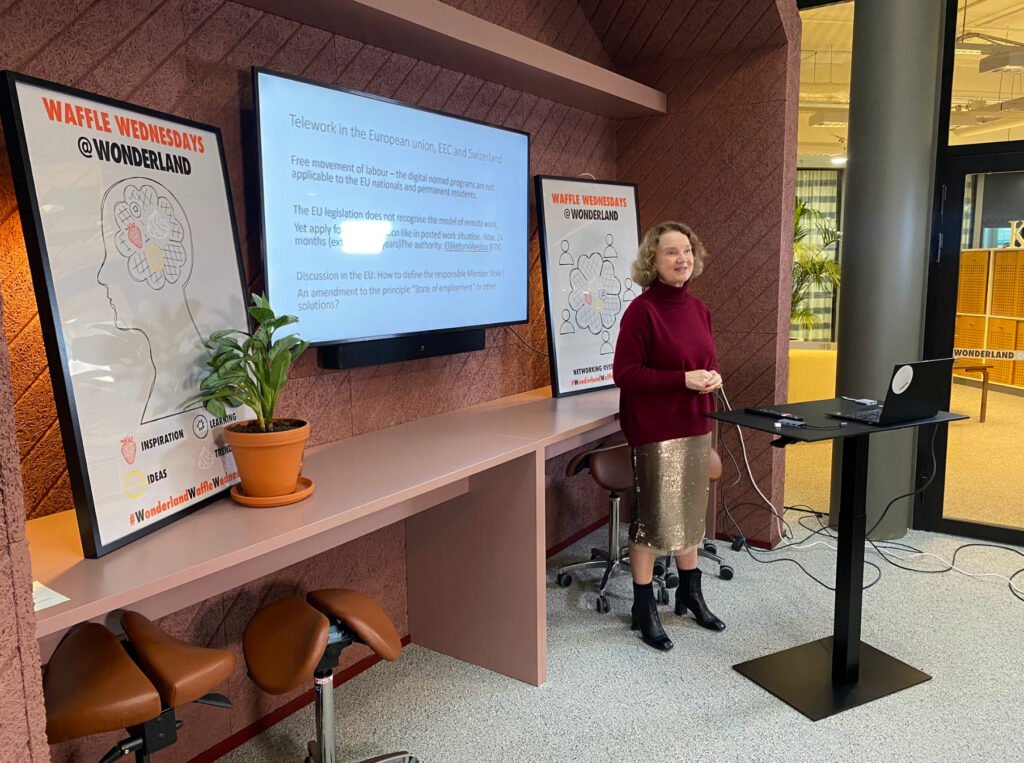Liisa Hämeen-Anttila visited Waffle Wednesdays on Wednesday 9.11. to talk about remote working across national borders and the related digital nomad phenomenon. Hämeen-Anttila works as a judge at an insurance court. She studied law in Finland and later specialised in international labour law and social security issues at KU Leuven, Belgium.
Much has happened in the field of cross-border remote working during recent years. The digital nomad phenomenon took off in the early days of the corona in spring 2020, when different countries started to develop specific visa programmes for digital nomads. Since then, programmes have emerged both in Europe and around the world, and there are currently diginomad programmes in around 50 countries. Countries such as Estonia, Portugal, Indonesia and Australia are well-known providers of such visa programmes.
What does digital nomad mean?
A digital nomad is someone who works remotely from anywhere in the world using modern technology. The term nomad originally referred to a small entrepreneur who travels from country to country and works remotely. However, the pandemic has broadened the scope of the term.
“Working from home during the Korona era gave rise to the idea that if you can work from home, why not work from anywhere? The term ‘digital nomad’ became more common in large companies when their employees were allowed to work for short periods from another country,” says Hämeen-Anttila.
Digital nomad is not a formal legal term, but more of a everyday expression. According to Hämeen-Anttila, digital nomad is not regulated as a term, nor is remote working. As a result, the legislation does not recognise these terms for insurance or tax purposes. The situation of digital nomads is therefore completely different from for example, expats, who are guaranteed certain rights by law.
“Participants in the digital nomad visa programme have very few rights in the host countries. It is therefore worth ensuring that the person travelling is entitled to Finnish social security. In this case, I recommend contacting the Finnish Centre for Pensions and Kela. For self-employed persons, it is advisable to ensure that their YEL insurance is valid throughout the trip. It is also absolutely essential to familiarise yourself with the taxation in the country of destination,” says Hämeen-Anttila.
Visa programmes can be thought of as a contract
If you compare the digital nomad visa with the traditional way of going abroad to work, you will notice clear differences. Workers sent by companies need a residence and work permit from their country of destination, while Hämeen-Anttila compares the digital nomad visa to a regular tourist visa, which allows a person to stay in the country for longer than usual.
The benefits of the digital nomad programmes vary depending on the country of destination but Hämeen-Anttila says there are also certain similarities:
“The requirement is that the digital nomad must not run his own business or do business in the host country or accept work from local companies. In general, the requirement is to commit to spending a certain period of time in the host country, often a year. They must also have health insurance in the host country and be able to prove that they have sufficient means of income.”
In return, tax relief or even full tax exemption is often offered. According to Hämeen-Anttila, the aim of these benefits is to attract wealthy and successful people who support local business but do not compete with it.
Hämeen-Anttila suggests that visa programmes are best thought of as a contracts:
“Consider whether the terms of the visa programme are best suited to your situation. A digital nomad visa is not suitable for someone who is looking for new business partners, for example. But for a more relaxed combination of work and travel, it’s a great solution.”
The European Union does not legally recognise the remote working model
Hämeen-Anttila says it is important to understand whether you are travelling within the Union, in its treaty countries or outside the Union:
“As there is freedom of movement within the Schengen area, digital nomad visas do not apply to EU citizens working remotely within the Union or its treaty countries. However, it is always worth finding out what is required in each country of destination, especially when travelling outside the Union,” she points out.
Hämeen-Anttila says that EU legislation does not recognise cross-border remote working. She says it will be interesting to see whether, as cross-border teleworking becomes more common, a completely new definition of working and remote working will be needed:
“The old idea of work is based on physical presence. But if the results and value of work are created elsewhere, would it be necessary to rethink terminology and legislation? Where do you actually work when you can work remotely from anywhere?”
If you are considering a digital nomad visa, remember these things:
- EU citizenship guarantees free travel within the Schengen area for EU citizens
- Do some research on the country of destination and its practices. In particular, it is worth looking into taxation.
- Entrepreneurs should be particularly aware that different practices in different countries make mobility more difficult, especially for self-employed people.
- Contact your insurance company and make sure they have all the necessary information about your trip. Also make sure that your personal and/or business insurance is still valid outside the Finnish borders.
- The Finnish Centre of Pensions recommends that you contact them even for short stays.
- It’s worth being prepared for anything. Do a risk assessment of the country and also take into account the political climate and climate changes.
LinkedIn: Liisa Hämeen-Anttila
Live video of the event can be found here. The event was held in Finnish.
Are you interested to become speaker at Waffle Wednesday hybrid event?
Sent us an email at hello@wonderlandwork.fi

